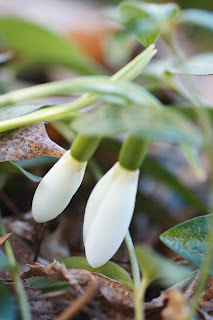 |
| Garlic mustard in flower |
Before we pour more volunteer power into fighting nonnatives, though, I think we should take a more nuanced look at the ideology behind this effort.
Of course, part of the reason that gardeners are concerned about nonnatives is that native animals, including the many insects we need near the base of the food web, haven’t evolved to live off these plants. One of the most eloquent spokesmen for this concern is Doug Tallamy, whose book Bringing Nature Home inspired many gardeners to choose native plants for our backyards. I’m on board with his recommendations, and I’m prioritizing natives when space opens up in my garden.
 |
| Native flowers feed native insects |
But it turns out that the science regarding nonnatives is not as simple as “natives good, exotics bad.” Recently I’ve read two fascinating books on this subject, The Rambunctious Garden: Saving Nature in a Post-Wild World, by Emma Marris, and Where Do Camels Belong: Why Invasive Species Aren’t All Bad, by Ken Thompson. Both provide many fascinating examples that illuminate the contradictions inherent in the simplistic strategy of making war on nonnative plants (sort of analogous to the problems with blaming human immigrants for our nation’s problems).
Two principles I’ve learned from these authors have changed my perceptions of imported plants and animals. First there’s the issue of baseline. What’s Year One for deciding who’s native and should be protected? In the US, many conservationists would choose 1492, assuming that introduction of new species to North America started with European settlement.
 |
| Plant migrations didn't start with the Pilgrims or even Columbus |
That presumes that Native Americans didn’t alter the landscape, which is completely untrue. It also ignores the climate shifts and changes in geography that have occurred over geologic time. Different plants grew in Massachusetts in warmer epochs than when glaciers advanced southward. We humans have a problem with historical perspective.
Second, when introduced plants take over, it’s usually in response to human-caused changes in habitat. We’re blaming the plants for the results of our own action.
 |
| I was surprised to learn that purple loosestrife is not reducing biodiversity in our wetlands |
How ever you come down on this highly emotional issue, there’s little chance of wiping out introduced plant species except in very special circumstances, such as on islands. We might pull all the garlic mustard from a beloved park, but seeds would be left behind in the soil, and plants don’t respect park boundaries. It’s a permanent commitment to moving a mountain with a teaspoon.
We’re just starting to understand invasion biology. Before we add more nonnative plants to our enemies list, let’s get more scientific evidence about how plant populations really work and save some energy for combating climate change, the biggest challenge of all for plants in the wild.
 |
| Plants can't migrate as fast as the climate is warming |


















